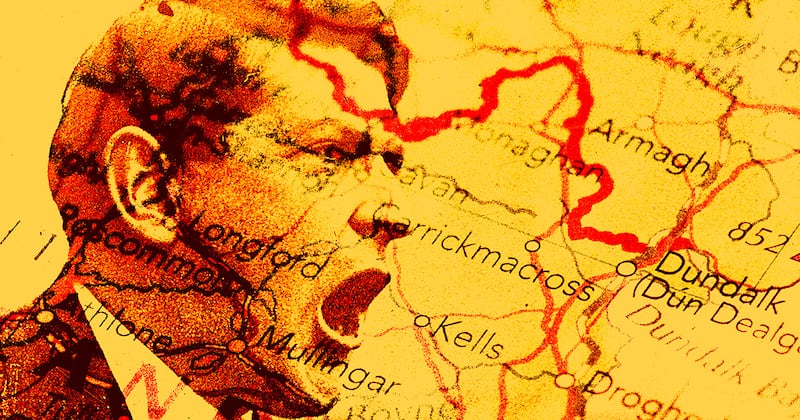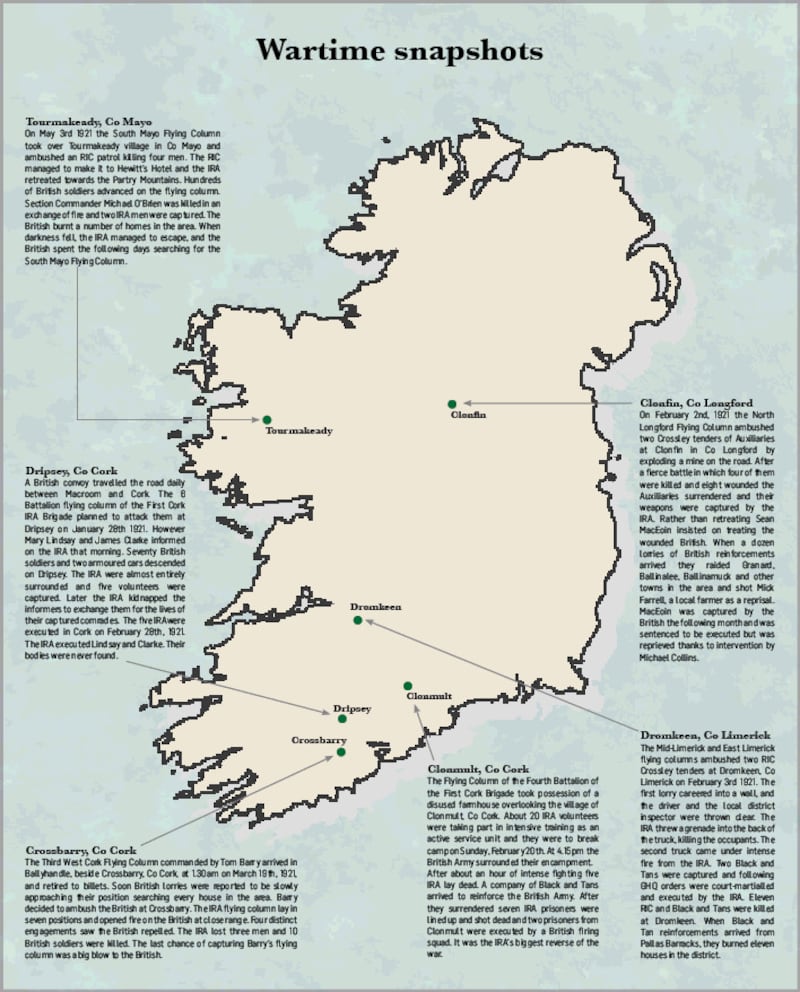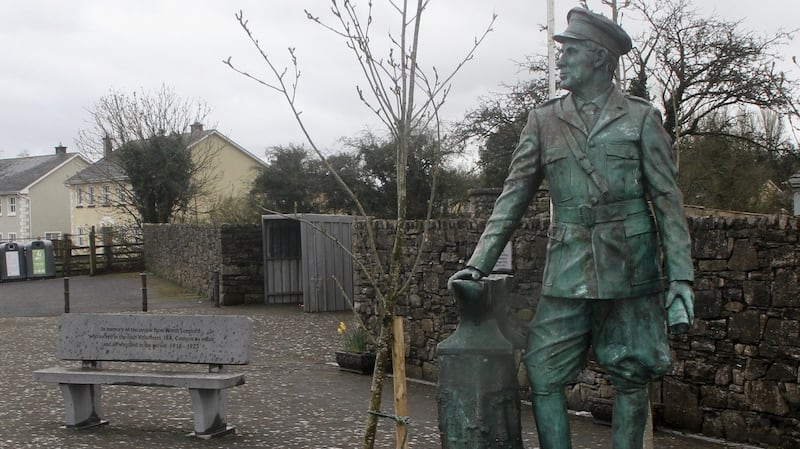In early 1921 Liberal British prime minister Lloyd George, heading a coalition government, was coming under both military and Conservative pressure to destroy the IRA. Following military advice, in January 1921 additional counties of Ireland were subjected to martial law. Kilkenny and Wexford were included in Leinster. The inclusion of Waterford and Clare ensured that the whole of Munster was now under British army rule. The IRA fought back, but at the end of January the Dripsey ambush in Cork was a disaster for the organisation when information on its plans was passed to the British army.
A policy of burning the ‘big houses’ of the landed gentry was pursed by the IRA in order to exact revenge for the British policy of burning local houses in reprisal for IRA ambushes. The IRA suffered a setback when volunteers unintentionally killed a number of civilians in an attack on a train at Upton on February 15th, which did little for public support. However, the actions of the Black and Tans and auxiliaries continued to offset such setbacks, arousing public horror and outrage.
After Clonmult, IRA men went on a mission in Cork city to shoot as many British soldiers as they could, in revenge for the executions being carried out under the military tribunals.


By 1921, the flying columns had become the backbone of the IRA campaign, with ambushes on barracks and convoys serving not alone to strike at the British but also to seize their much-coveted arms. Tom Barry of the Third West Cork flying column was one of the most successful of all the flying column leaders and was responsible for the Kilmichael ambush of November 28th which killed 16 auxiliaries. The British very nearly captured his entire flying column of more than 100 IRA volunteers at Crossbarry.
Arms were always an issue for the IRA, which relied heavily on attacks on barracks to seize much-needed weaponry. The Thompson submachine gun (Tommy gun), the development of which was funded by the IRA, could have changed the course of the war if the shipment ordered had arrived in time; such an effective weapon would have bolstered the IRA and destroyed the morale of the British forces in Ireland.
On May 25th, the Dublin brigade of the IRA set fire to one of the economic symbols of British rule in Ireland, the Custom House, where hundreds of thousands of taxation records were stored. There was a fierce fight between the IRA and the British, and a large number of IRA men were taken prisoner. Both sides were now being pushed towards negotiation. Lloyd George, having concluded that the British military campaign could not continue, decided to drop his precondition of arms surrender before any negotiation could take place. This made it possible for peace talks to begin and, on July 11th, 1921, the British offered a truce.
Dripsey, Co Cork
A British convoy travelled the road daily between Macroom and Cork. The 6 Battalion flying column of the First Cork IRA brigade planned to attack them at Dripsey on January 28th, 1921. However, Mary Lindsay and James Clarke informed on the IRA that morning. Seventy British soldiers and two armoured cars descended on Dripsey. The IRA were almost entirely surrounded and five volunteers were captured. Later the IRA kidnapped the informers to exchange them for the lives of their captured comrades. The five IRA volunteers were executed in Cork on February 28th, 1921. The IRA executed Lindsay and Clarke. Their bodies were never found.

Clonfin, Co Longford
On February 2nd, 1921 the North Longford flying column ambushed two Crossley tenders of auxiliaries at Clonfin in Longford by exploding a mine on the road. After a fierce battle in which four of them were killed and eight wounded the auxiliaries surrendered and their weapons were captured by the IRA. Rather than retreating, the flying column's leader, Seán Mac Eoin, insisted on treating the wounded British. When a dozen lorries of British reinforcements arrived they raided Granard, Ballinalee, Ballinamuck and other towns in the area and shot Mick Farrell, a local farmer, as a reprisal. Mac Eoin was captured by the British the following month and was sentenced to be executed but was reprieved thanks to the intervention of Michael Collins.
Dromkeen, Co Limerick
The Mid-Limerick and East Limerick flying columns ambushed two RIC Crossley tenders at Dromkeen, Limerick on February 3rd 1921. The first lorry careered into a wall, and the driver and the local district inspector were thrown clear. The IRA threw a grenade into the back of the truck and killing the occupants. The second truck came under intense fire from the IRA. Two Black and Tans were captured and following orders from general headquarters were court-martialled and executed by the IRA. Eleven RIC and Black and Tans were killed at Dromkeen. When Black and Tan reinforcements arrived from Pallas barracks, they burned 11 houses in the district.
Clonmult, Co Cork
The flying column of the fourth battalion of the First Cork Brigade took possession of a disused farmhouse overlooking the village of Clonmult, near Midleton in Co Cork. About 20 IRA volunteers were taking part in intensive training as an active service unit and they were to break camp on Sunday, February 20th. At 4.15pm that day that the British army surrounded their encampment. After about an hour of intense fighting five IRA lay dead. A company of Black and Tans arrived to reinforce the British army. After they surrendered, seven IRA prisoners were lined up and shot dead and two prisoners from Clonmult were executed by a British firing squad. It was the IRA’s biggest reverse of the war.
Crossbarry, Co Cork
The Third West Cork flying column commanded by Tom Barry arrived in Ballyhandle, beside Crossbarry, Co Cork, at 1.30am on March 19th, 1921, and retired to billets. Soon British lorries were reported to be slowly approaching their position, searching every house in the area. Barry decided to ambush the British at Crossbarry. The IRA flying column lay in seven positions and opened fire on the British at close range. Four distinct engagements saw the British repelled. The IRA lost three men and 10 British soldiers were killed. The last chance of capturing Barry’s flying column was a big blow to the British.
Tourmakeady, Co Mayo
On May 3rd, 1921, the South Mayo flying column took over Tourmakeady village in Mayo and ambushed an RIC patrol, killing four men. The RIC managed to make it to Hewitt's hotel and the IRA retreated towards the Partry mountains. Hundreds of British soldiers advanced on the flying column. Section commander Michael O'Brien was killed in an exchange of fire and two IRA men were captured. The British burned a number of homes in the area. When darkness fell, the IRA managed to escape, and the British spent the following days searching for the elusive South Mayo flying column.
Lorcan Collins is founder of the 1916 Walking Tour of Dublin. His latest book is Ireland’s War of Independence 1919-1921 - The IRA’s Guerrilla Campaign. He is host of the Revolutionary Ireland Podcast









